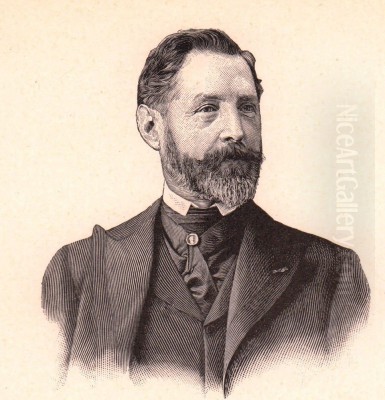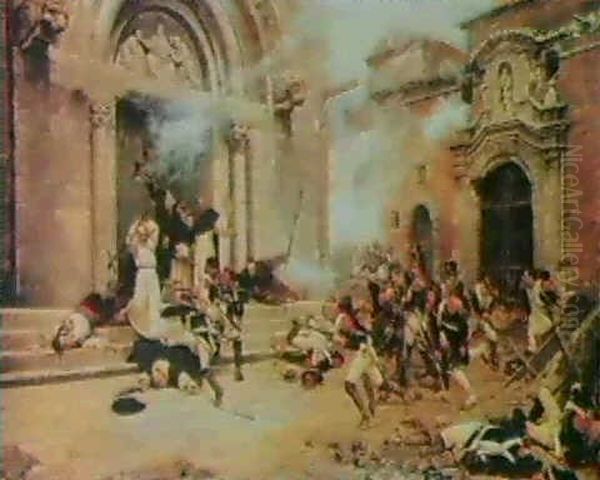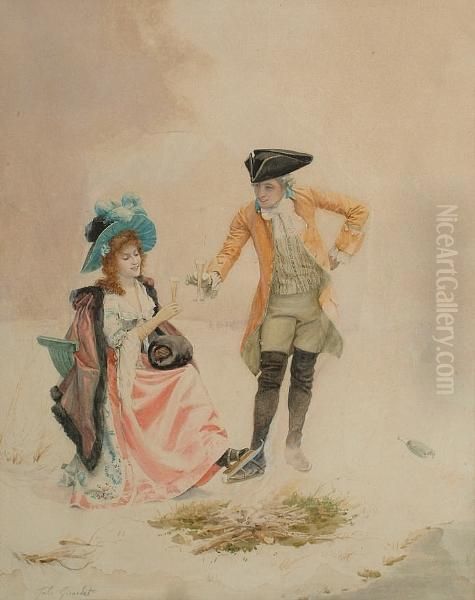
Jules Girardet (1856–1938) stands as a significant, if sometimes overlooked, figure in late 19th and early 20th-century French art. A painter of considerable skill and dedication, he carved a niche for himself primarily through his evocative historical scenes, particularly those depicting the tumultuous era of the French Revolution and its aftermath. His work, characterized by meticulous detail, dramatic compositions, and a keen sense of narrative, offers a valuable visual portal into France's past. Beyond historical canvases, Girardet also explored portraiture and genre scenes, often imbued with a subtle romanticism. Born into a distinguished family of artists, he inherited a tradition of craftsmanship and artistic pursuit, which he skillfully adapted to his own thematic concerns and stylistic preferences.
An Artistic Heritage and Formative Years
Jules Girardet was born in Paris on April 10, 1856, into a family with deep artistic roots. His father, Paul Girardet (1821–1893), was a respected Swiss-born copper engraver. Artistry was a familial trait, with Jules's brothers, Eugène Girardet (1853–1907) and Léon Girardet (1857–1895), also becoming accomplished painters. Eugène, in particular, gained fame as an Orientalist painter, capturing the landscapes and cultures of North Africa. This environment undoubtedly fostered Jules's early inclination towards the arts.
He received his formal artistic training at the prestigious École des Beaux-Arts in Paris, a bastion of academic tradition. There, he studied under Alexandre Cabanel (1823–1889), one of the most influential academic painters of the Second Empire. Cabanel, known for his historical, classical, and religious subjects, as well as his portraits (most famously "The Birth of Venus"), would have instilled in Girardet a strong foundation in drawing, composition, and the meticulous rendering of form. This academic grounding is evident throughout Girardet's oeuvre, even as he developed his own distinct narrative style. The influence of academic history painting, as championed by figures like Jean-Léon Gérôme (1824–1904) and William-Adolphe Bouguereau (1825–1905), who were contemporaries and often rivals of Cabanel, shaped the artistic landscape in which Girardet matured.
The Crucible of Revolution: Depicting France's Defining Moments

Jules Girardet is perhaps best remembered for his powerful depictions of the French Revolution, the Chouannerie, and the Napoleonic Wars. He possessed a remarkable ability to translate complex historical events into compelling visual narratives, often focusing on moments of high drama, human suffering, or pivotal confrontations. His approach combined a concern for historical accuracy in costume and setting with a romantic sensibility that heightened the emotional impact of his scenes.
One of his most celebrated works in this vein is The Rebels of Fouesnant Returned to Quimper by the National Guard in 1792 (also known as Les révoltés de Fouesnant ramenés à Quimper par la garde nationale en 1792). This painting, with versions existing in the Musée des Beaux-Arts de Quimper and private collections, captures a specific episode from the Chouannerie, the royalist peasant uprising in Brittany against the First Republic. Girardet meticulously details the dejected yet defiant expressions of the captured rebels, the stern resolve of the National Guard, and the somber atmosphere of the procession. The work is noted for its "serious documentary" style, reflecting a desire to record the event with a degree of verisimilitude, though imbued with an undeniable dramatic pathos.
Another significant historical work is The Burning of Paris (L'Incendie des Tuileries pendant la Commune de Paris en 1871), housed in the Musée Carnavalet in Paris. This painting tackles a more contemporary, yet equally traumatic, event: the Paris Commune of 1871. Girardet portrays the chaos and destruction as the Tuileries Palace is engulfed in flames, a potent symbol of the violent upheaval. His depiction of Louise Michel, a prominent figure in the Paris Commune, on the barricades further underscores his interest in the human element within these grand historical narratives. Such works placed him in a tradition of artists who documented contemporary conflicts, a lineage that includes earlier figures like Francisco Goya (1746-1828) with his "Disasters of War" series, though Girardet's approach was less overtly critical and more focused on the dramatic unfolding of events.
Girardet also turned his attention to the Napoleonic era. His painting Napoleon on Board the Bellerophon at Plymouth, 1815, now in the collection of The Box, Plymouth, depicts the defeated emperor aboard the British warship that would transport him to his final exile on Saint Helena. The work captures a moment of profound historical significance, focusing on the isolated and contemplative figure of Napoleon, a theme also explored by other artists like Paul Delaroche (1797-1856) in his famous depictions of Napoleon.

Other historical subjects tackled by Girardet include The Siege of Saragossa, referencing the brutal Peninsular War conflict, and The Disaster of Quiberon, another episode from the French Revolutionary Wars, specifically the failed royalist landing in 1795. These paintings demonstrate his consistent engagement with themes of conflict, heroism, and the human cost of war, aligning him with other prominent historical painters of his era such as Jean-Paul Laurens (1838–1921) and Ernest Meissonier (1815–1891), the latter renowned for his incredibly detailed military scenes.
Beyond the Battlefield: Genre Scenes and Romanticism
While historical epics formed the core of his reputation, Jules Girardet also excelled in creating more intimate genre scenes and portraits. These works often reveal a softer, more romantic side to his artistic personality. The Lovers (Les Amoureux) is a prime example, showcasing a tender moment between a couple in a lush, romantic garden setting. The painting is characterized by delicate brushwork, a warm palette, and an atmosphere of idyllic charm, demonstrating his versatility and ability to capture nuanced human emotions. This aspect of his work shows an affinity with the broader Romantic movement that had swept through Europe earlier in the 19th century, with artists like Eugène Delacroix (1798–1863) championing emotional intensity and individualism, though Girardet's romanticism was often more restrained and sentimental.
His painting On the Shores of Lake Geneva (Au bord du Lac Léman), housed in the Kunstmuseum Bern, Switzerland, further illustrates his skill in landscape and genre. Such pieces allowed him to explore different atmospheric effects and compositional strategies than those demanded by his grand historical canvases. These works often possess a quiet charm and reflect the enduring appeal of everyday life and picturesque scenery in 19th-century art.
In the summer of 1877, Girardet, along with fellow artists Evert Louis van Muyden (1853–1922) and Max Leenhardt (1853–1941), embarked on an exploratory journey through Normandy and Brittany. This experience of sketching and painting en plein air or gathering material for studio work was common among artists of the period and likely enriched his understanding of landscape and local color, which would have informed both his genre scenes and the settings of his historical paintings. Such collaborative trips were part of the fabric of artistic life, fostering shared experiences and mutual influences.
Artistic Style and Technique
Jules Girardet's style was firmly rooted in the academic tradition of the 19th century, emphasizing strong draftsmanship, balanced compositions, and a high degree of finish. His training under Cabanel ensured a mastery of anatomy and perspective, which lent credibility to his complex historical reconstructions. He paid considerable attention to historical detail, particularly in rendering costumes, weaponry, and architectural settings, which contributed to the "documentary" feel of some of his works.
However, Girardet was not merely a dry chronicler. He infused his historical scenes with a palpable sense of drama and emotion. His compositions are often dynamic, employing diagonal lines and contrasting groups of figures to create visual tension and guide the viewer's eye through the narrative. His use of color, while generally naturalistic, could be employed for expressive effect, highlighting key figures or enhancing the mood of a scene – from the somber tones of defeat to the fiery reds and oranges of a conflagration.
There's a clear narrative intent in his paintings; he was a storyteller in visual form. Each gesture, expression, and grouping of figures contributes to the unfolding drama. This narrative clarity made his works accessible and engaging to a wide audience, who could readily understand the events and empathize with the characters depicted. While the Impressionist revolution, led by figures like Claude Monet (1840–1926) and Edgar Degas (1834–1917), was challenging academic conventions during Girardet's career, he largely remained committed to a more traditional, representational mode of painting, which continued to find favor with the Salon juries and the public. His style shows some influence from François Flameng (1856–1923), a contemporary also known for historical scenes and portraits, who similarly balanced academic skill with a flair for dramatic narrative.
Exhibitions, Awards, and Recognition
Jules Girardet was a regular participant in the prestigious Paris Salon, the official art exhibition of the Académie des Beaux-Arts, which was the primary venue for artists to gain recognition and patronage. His consistent presence at the Salon indicates his acceptance within the established art world of his time.
His talent did not go unnoticed. In 1881, he was awarded a third-class medal at the Salon, a significant honor that acknowledged his skill and contribution. He achieved further recognition at the Exposition Universelle of 1889 in Paris, where he received a bronze medal and prize money. These accolades cemented his reputation as a capable and respected historical painter. His works were not only exhibited in Paris but also found their way into exhibitions in Switzerland, reflecting an international dimension to his career. The acquisition of his works by museums such as the Musée des Beaux-Arts de Quimper, the Musée Carnavalet in Paris, and the Kunstmuseum Bern further attests to his contemporary standing.
The Girardet Artistic Dynasty
Jules Girardet was part of a notable lineage of artists. His father, Paul Girardet, was an engraver, and his Swiss grandfather, Charles Girardet (1780-1863), was also an artist. His uncles, Karl Girardet (1813–1871) and Edouard Henri Girardet (1819–1880), were painters of repute, with Karl known for his historical and genre scenes, often with an Orientalist flavor, and Edouard for his genre scenes and engravings.
Jules's brothers, Eugène and Léon, continued this artistic tradition. Eugène Girardet became a particularly well-known Orientalist painter, traveling extensively in North Africa and producing vivid depictions of desert life, much like other French Orientalists such as Jean-Auguste-Dominique Ingres (1780–1867) in his odalisques (though Ingres's Orientalism was more studio-based) or Théodore Chassériau (1819–1856). Léon Girardet also pursued a career as a painter, focusing on genre subjects. This strong family background in the arts provided a supportive and stimulating environment for Jules, and the collective achievements of the Girardet family represent a significant contribution to 19th-century European art.
Legacy and Art Historical Significance
Jules Girardet's primary contribution to art history lies in his role as a visual chronicler of French history, particularly the revolutionary and post-revolutionary periods. His paintings served not only as artistic endeavors but also as powerful tools for shaping public memory and understanding of these pivotal events. In an era before photography became widespread for news dissemination, historical paintings played a crucial role in visualizing the past for a broad audience.
His works are characterized by a blend of academic precision and romantic drama, making them both informative and emotionally engaging. While he may not have been an avant-garde innovator in the mold of the Impressionists or Post-Impressionists like Paul Cézanne (1839–1906) or Vincent van Gogh (1853–1890), who were his contemporaries, Girardet excelled within the established conventions of historical and genre painting. He provided a vivid and often poignant visual record of conflict, heroism, and everyday life, contributing significantly to the rich tapestry of 19th-century French art.
His paintings continue to be valued for their historical insights, their narrative power, and their technical accomplishment. They offer a window into the concerns and sensibilities of his time, reflecting a period when grand historical narratives still held a powerful sway over the artistic imagination. The continued presence of his works in museum collections and their appearance in art historical discussions ensure that Jules Girardet's contribution to the visual culture of France endures. He passed away in Paris in January 1938, leaving behind a substantial body of work that continues to speak to audiences today.